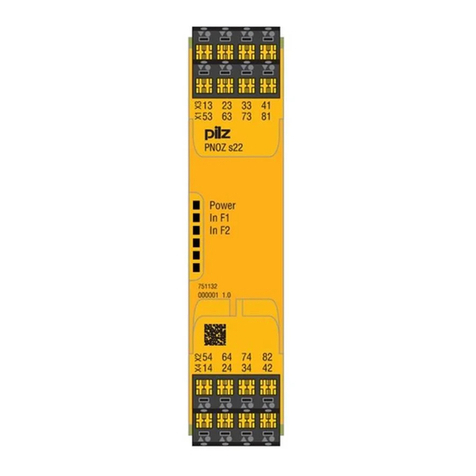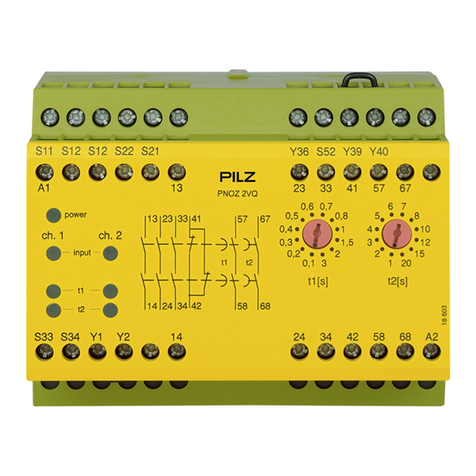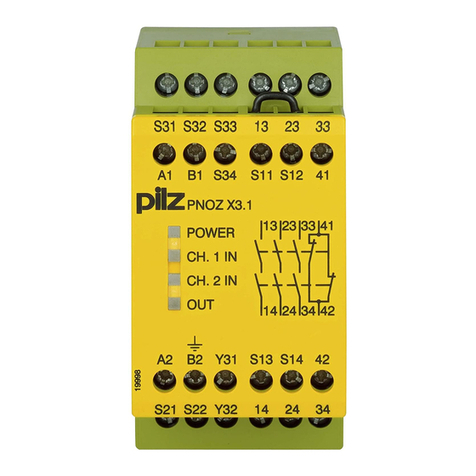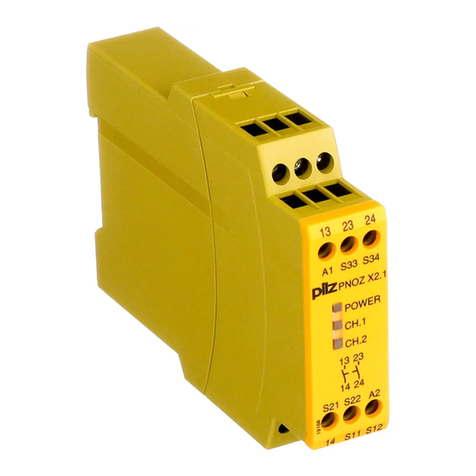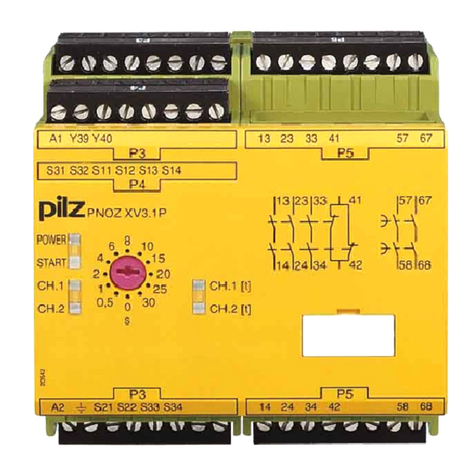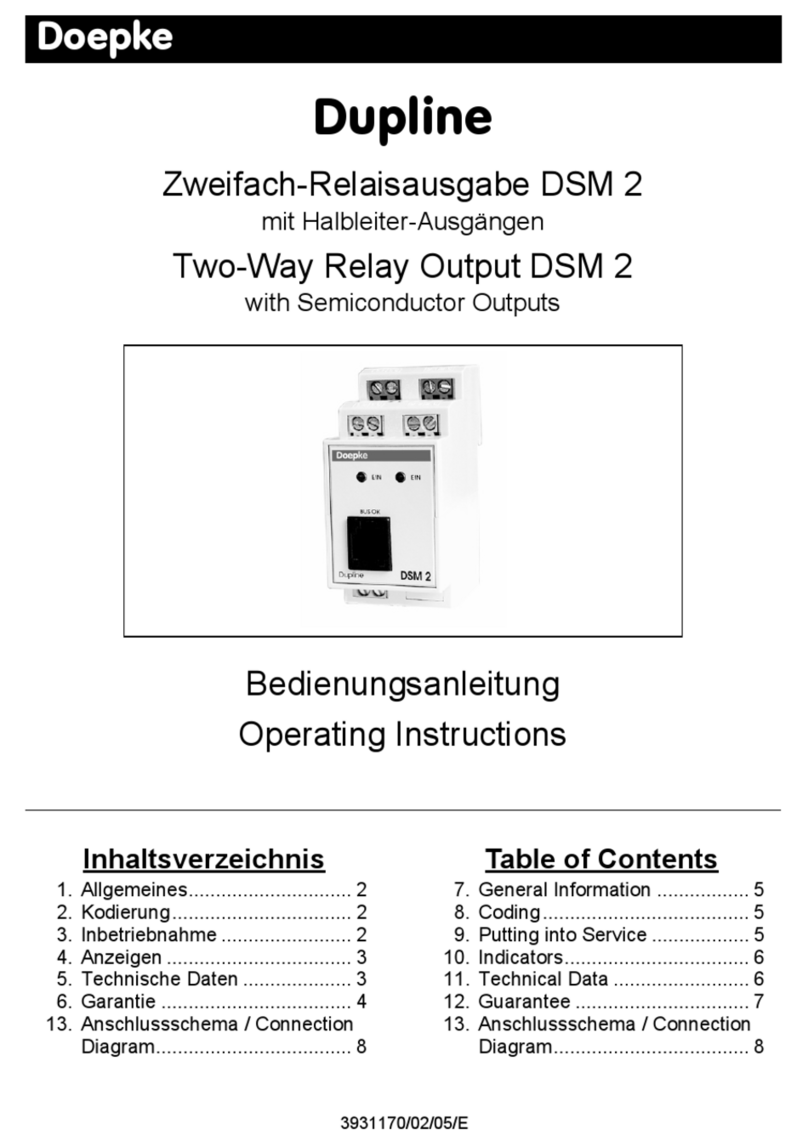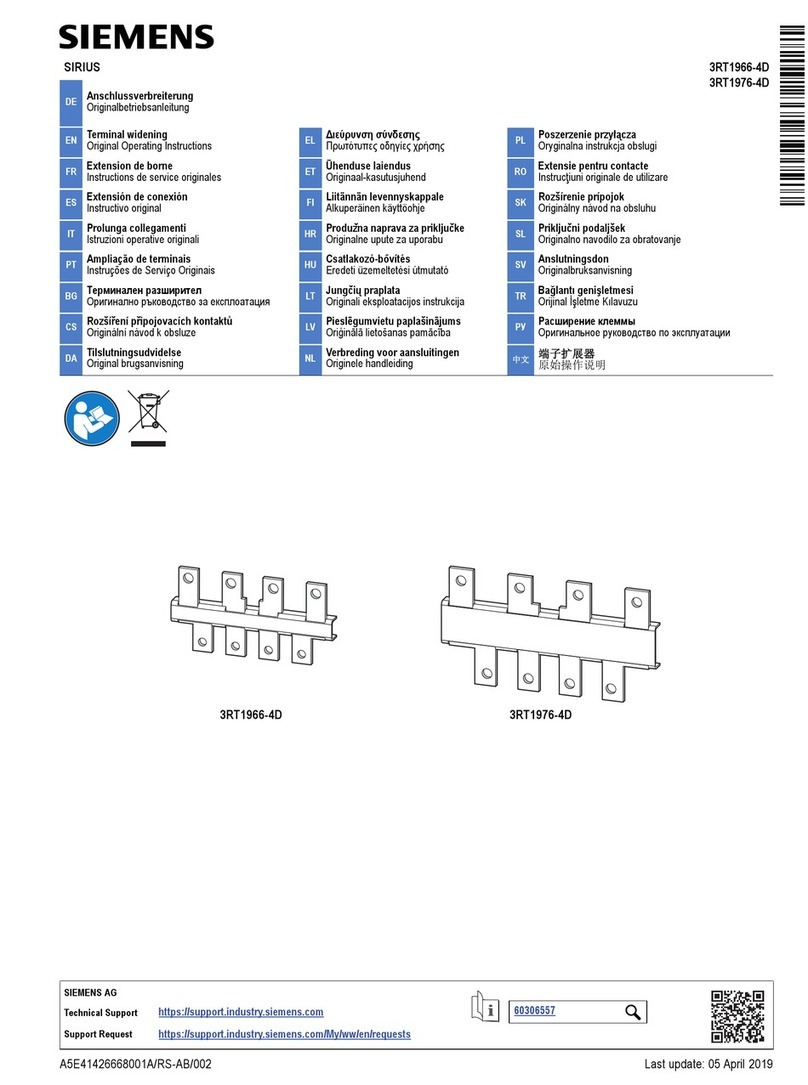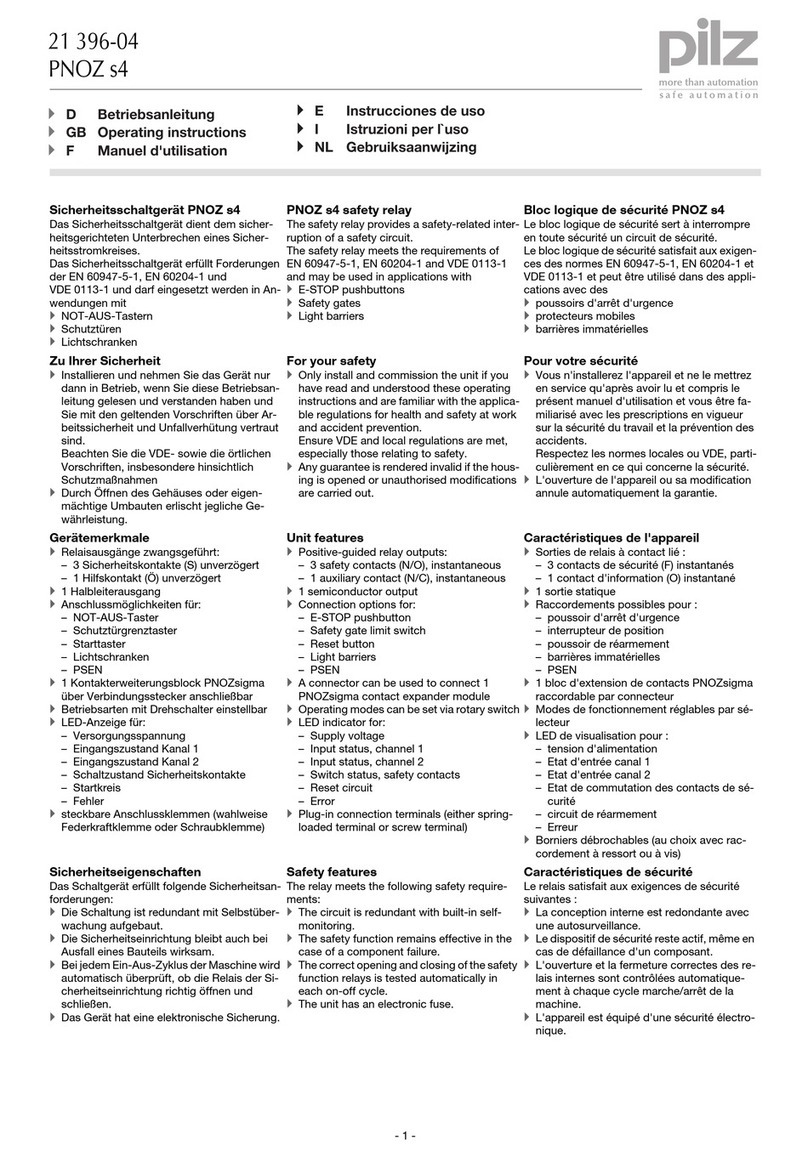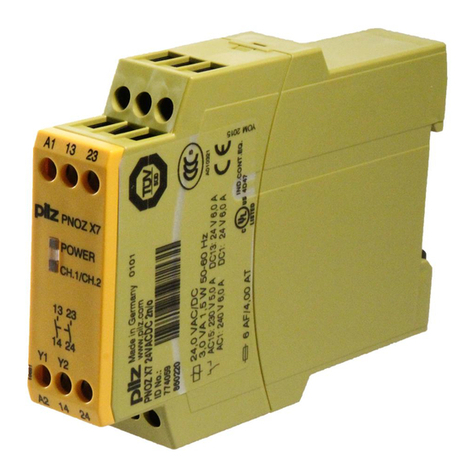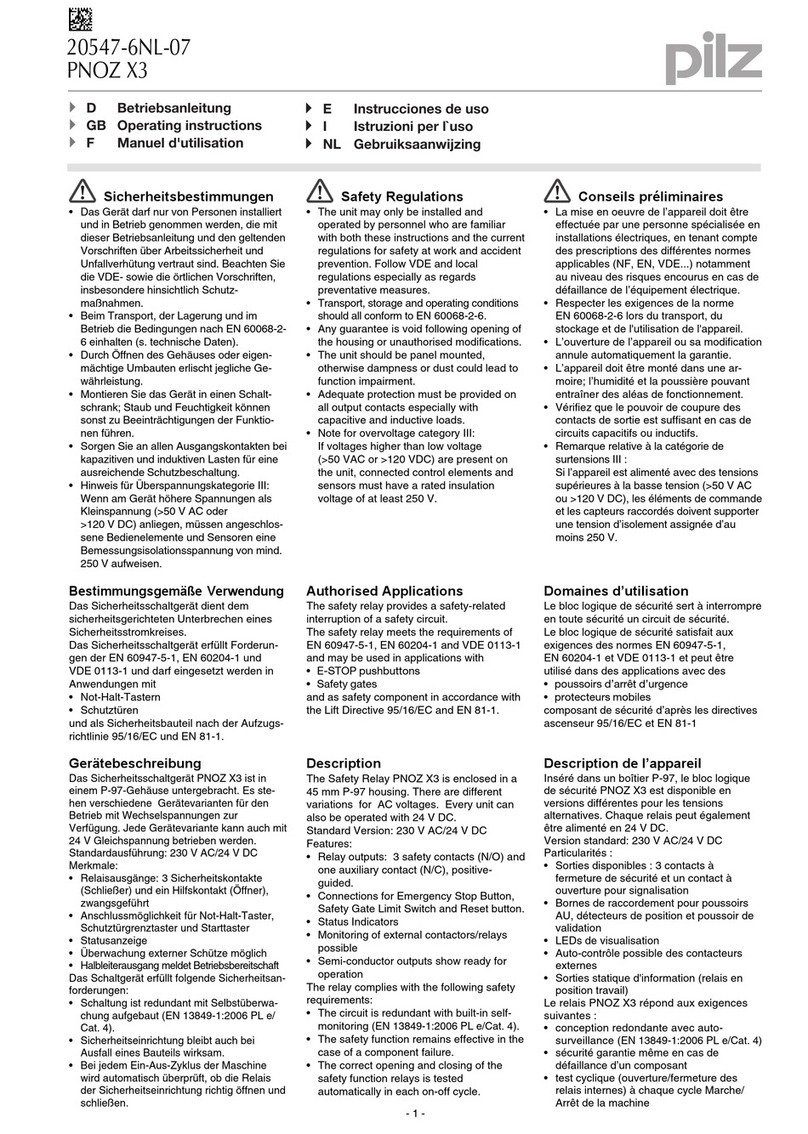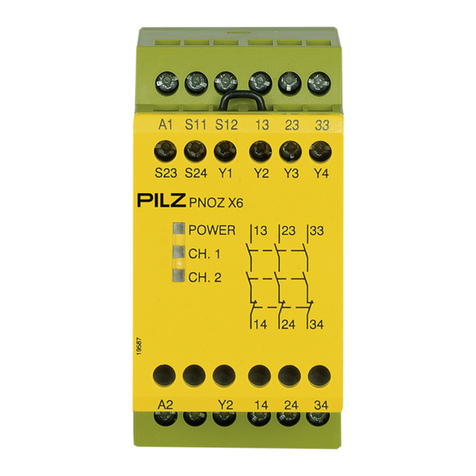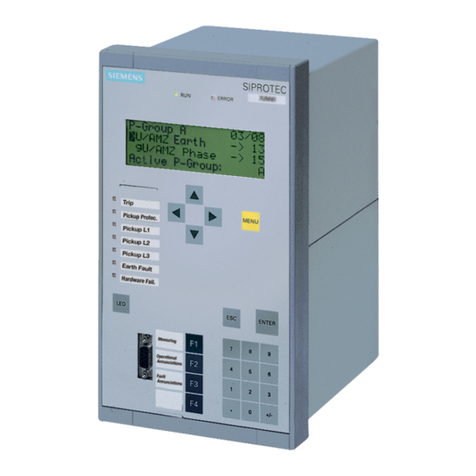
- 3 -
Betriebsarten:
• Einkanaliger Betrieb:
Eingangsbeschaltung nach VDE 0113 und
EN 60204, keine Redundanz im Eingangs-
kreis. Erdschlüsse im Tasterkreis werden
erkannt.
• Zweikanaliger Betrieb: Redundanter Ein-
gangskreis, Erdschlüsse im Tasterkreis
werden erkannt.
• Automatischer Start: Gerät ist aktiv, sobald
der Eingangskreis geschlossen ist.
• Manueller Start: Gerät ist erst dann aktiv,
wenn ein Starttaster betätigt wird. Dadurch
ist ein automatischer Start des Schalt-
geräts nach Spannungsausfall und -
wiederkehr ausgeschlossen.
• Kontaktvervielfachung und -verstärkung
durch Anschluss von externen Schützen.
Montage
Das Sicherheitsschaltgerät muss in einen
Schaltschrank mit einer Schutzart von mind.
IP54 eingebaut werden. Zur Befestigung auf
einer Normschiene hat das Gerät ein
Rastelement auf der Rückseite.
Inbetriebnahme
Beachten Sie bei der Inbetriebnahme:
• Nur die Ausgangskontakte 13-14/23-24/
33-34/57-58/67-68) sind Sicherheits-
kontakte. Ausgangskontakt 41-42 ist ein
Hilfskontakt (z. B. für Anzeige).
•Vor die Ausgangskontakte eine
Sicherung (10 A flink oder 6,3 A träge)
schalten, um das Verschweißen der
Kontakte zu verhindern.
• Eingangskreis
Temperatur: +25 °C
Max. Leitungslängen:
- Leiterquerschnitt: 1,5 mm2
DC: 3500 m
• Das Anzugsdrehmoment der Schrauben
auf den Anschlussklemmen darf max.
0,8 Nm betragen.
• Leitungsmaterial aus Kupferdraht mit
einer Temperaturbeständigkeit von
60/75 °C verwenden.
• Angaben im Kapitel "Technische Daten"
unbedingt einhalten.
Ablauf:
• Verzögerungszeit t1 für Sicherheitskontakt
57-58 und t2 für Sicherheitskontakt 67-68
mit Hilfe eines Schraubendrehers festle-
gen.
• Betriebsspannung an Klemmen A1 (-) und
A2 (+) anlegen.
• Rückführkreis schließen
Brücke an Y1-Y2 oder externe Schütze
anschließen.
• Aktivierungskreis schließen
- Automatischer Start: S33-S34 brücken.
-
Manueller Start: Taster an S33-S34
anschließen (keine Brücke an S33-S34).
• Eingangskreis schließen
- Einkanalig: S12-S22 brücken. Öffner-
kontakt von Auslöseelement an S11 und
S12 anschließen.
- Zweikanalig: Öffnerkontakt von Auslöse-
element an S11-S12/S11-S22 anschlie-
ßen.
• Reset-Eingang schließen
- ohne Reset-Funktion: Y39-Y40 brücken.
- mit Reset-Funktion: Öffnerkontakt an
Y39-Y40 anschließen.
Operating Modes:
• Single-Channel Operation: Input wiring
according to VDE 0113 and EN 60204, no
redundancy in the input circuit, earth fault
detection in the Emergency-Stop Button
Circuit
• Two-Channel Operation: redundancy in
the input circuit, earth fault detection in the
Emergency-Stop Button Circuit
• Automatic reset: the device is activated as
soon as the input circuit is closed
• Manual reset: the device is only activated
after a reset button is pressed. This
prevents automatic start-up following a
loss/return of supply voltage
• Increase in the number of available
contacts by connection of external
contactors/relays
Installation
The safety relay must be panel (min. IP54)
mounted. There is a notch on the rear of the
unit for DIN rail attachment.
Operation
Please note for operation:
• Only the output contacts 13-14, 23-24, 33-
34, 57-58 and 67-68 are safety contacts.
• Output contact 41-42 is an auxiliary signal
contact (e.g. for a signal lamp).
•A 10 A fast or 6.3 A slow acting fuse
must be connected before the output
contacts, to prevent welding of the
contacts.
• Input Circuit
Temperature: +25 °C
Max. cable lengths:
- Cable: 1.5 mm2
DC: 3500 m
• Tighten terminals to 0,8 Nm.
• Use copper wire that can withstand
60/75 °C.
• Important details in the section „Technical
Data“ should be noted and adhered to.
To operate:
• Adjust the desired delay time t1 of contact
57-58 and t2 of contact 67-68, using a
screwdriver
• Connect the supply voltage leads to
terminals A1 (-) and A2 (+)
• Close the Feedback Control Loop
Y1 - Y2 bridged, or connect the contacts
of external contactors/relays
• Close the Activation Circuit
- Automatic reset: Terminals S33-S34
bridged
- Manual reset: Replace the bridge S33-
S34 with a n/o contact of a pushbutton
• Close the Input Circuit
- Single Channel: Terminals S12-S22
bridged. Connect a n/c contact of the
activating switch to S11-S12
- Two-Channel: Connect n/c contacts of
the activating switch to terminals S11-
S12 and S11-S22
• Close the Reset Circuit
- without reset function: Bridge terminals
Y39-Y40
- with reset function: Replace the bridge
Y39-Y40 with a n/c contact
Montage
Le relais doit être monté dans l'armoire
électrique ayant au min. un indice de
protection IP54. Sa face arrière permet un
montage rapide sur rail DIN.
Mise en oeuvre
Remarques préliminaires:
• Seuls les contacts 13-14/23-24/33-34/57-
58/67-68 sont des contacts de sécurité.
Le contact 41-42 est un contact
d'information.
• Protection des contacts de sortie par
des fusibles (10 A rapides ou 6,3 A
normaux) pour éviter leur soudage.
• Circuit d’entrée
température: +25 °C
longueur maxi. câblage:
- câble: 1,5 mm2
DC: 3500 m
• Le couple de serrage sur les bornes de
racordement ne doit pas dépasser
0,8 Nm.
• Utiliser uniquement des fils de câblage en
cuivre 60/75 °C.
• Respectez les données indiquées dans les
caractéristiques techniques.
Mise en oeuvre:
• Régler la temporisation t1 du contact
57-58 et la temporisation t2 du contact
67-68 à l'aide d'un tournevis.
• Amener la tension d'alimentation aux
bornes A1 (+) et A2 (-)
• Fermer la boucle de retour:
pont entre Y1-Y2 ou câblage des
contacts externes.
• Fermer le circuit de réarmement:
- réarmement automatique: pontage des
bornes S33-S34.
- réarmement manuel: câblage d'un
poussoir sur S33-S34 (pas de
pontage).
• Fermer le circuit d'entrée:
- commande par 1 canal: câblage du
contact à ouverture entre S11 et S12,
pontage de S12-S22
- commande par 2 canaux: câblage des
contacts à ouverture entre S11-S12/
S21-S22.
• Fermer la boucle de Reset:
- sans fonction Reset: pont sur Y39-Y40
- avec fonction Reset: câblage d'un
contact à ouverture sur Y39-Y40.
Mode de fonctionnements:
• commande par 1 canal: conforme aux
prescriptions de la norme EN 60204, pas
de redondance dans le circuit d'entrée.La
mise à la terre du circuit d'entrée est
détectée.
• commande par 2 canaux : circuit d'entrée
redondant, la mise à la terre du circuit
d'entrée est détectée.
• Réarmement automatique: le relais est
activé dès la fermeture du circuit d'entrée.
• Réarmement manuel: le relais n'est activé
qu'après une impulsion sur le poussoir de
réarmement. Un réarmement automatique
du relais après une coupure d'alimentation
est ainsi impossible
• Augmentation du nombre de contacts ou
du pouvoir de coupure par l'utilisation de
contacteurs externes
